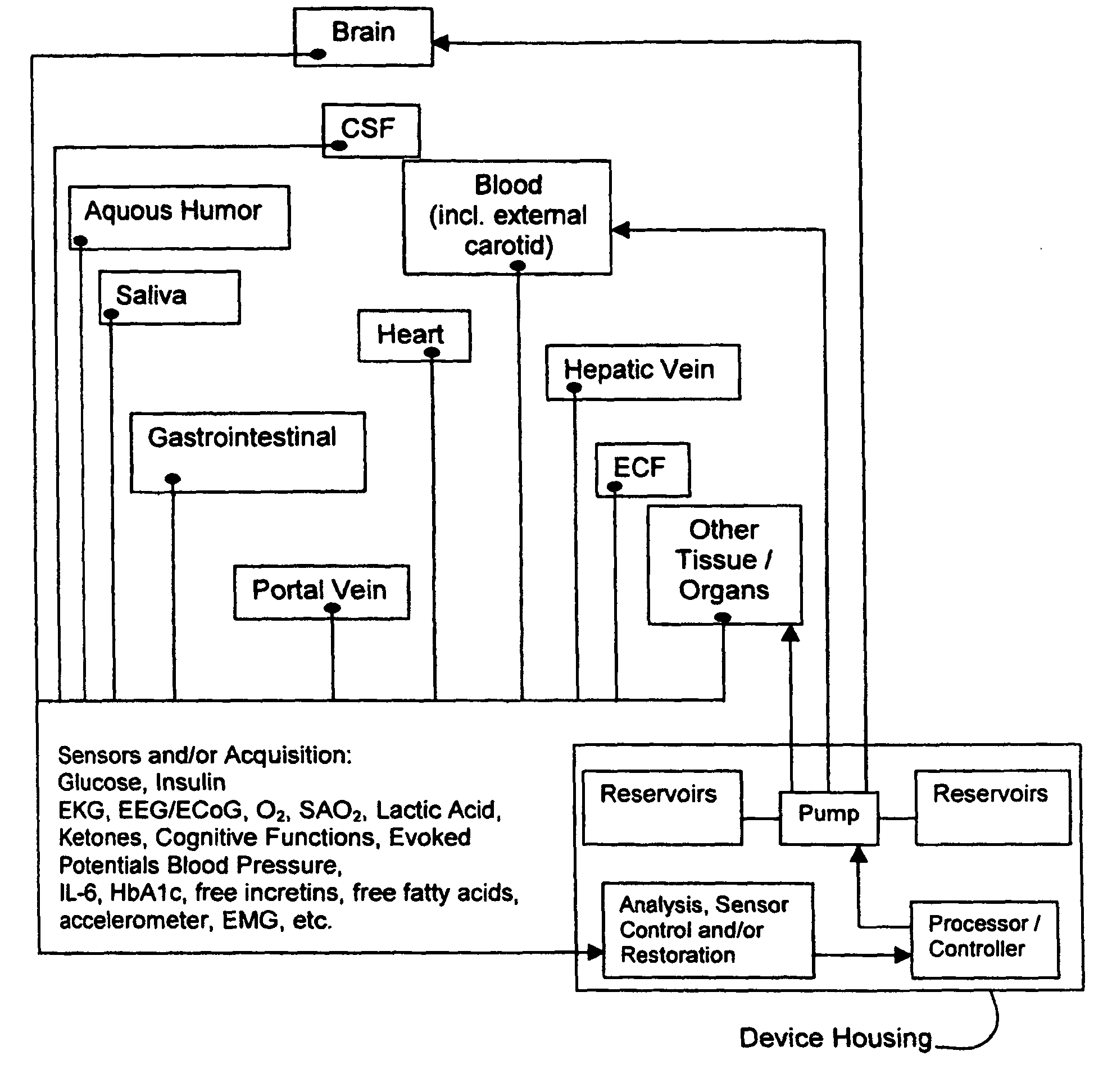However, attempts to maintain near-normal glycemia often increase the risk of
hypoglycemia.
Although patients may perform self-monitored blood glucose (SMBG) tests four or more times per day, many episodes of hypoglycemia go undetected due to the absence of overt symptoms or because they occur at night, when
glucose testing is rare.
As a result, hypoglycemia is responsible for dramatic economic costs and many avoidable deaths each year.
This technology has been in development for quite some time, but the first prior art device only became commercially available in the past few years.
The aforesaid prior art device can only operate for up to three days, which is certainly not a permanent solution, but one that yields enough information to improve a person's
treatment regimen.
The main challenge in developing a glucose sensor for implantation beneath the
skin or in a
vein is to maintain the sensors performance when it is exposed to the inside of the body over long periods of time.
Almost without exception, interactions with the body cause a decrease in sensor sensitivity.
The glucose-blocking barrier thus created blunts sensor sensitivity and lengthens
response time.
In addition, the body's warm, electrolytic environment corrodes
metal electrodes and can inactivate enzymes, which leads to loss of measurement sensitivity and stability.
Movement by a person wearing the device can create artifacts and
noise that decrease sensitivity and specificity to glucose signals and also produce mechanical stresses that affect stability.
Another problem is that when glucose levels are high,
oxygen may become the limiting reactant in the electrochemical sensing scheme that prior art devices utilize.
The result is
signal saturation and a limited
system operating range.
(1) Existing
glycemic control and
delivery methods / systems do not mimic the anatomo-
physiologic process of
whole body glucose
metabolism and regulation, including
route and mode, rate and timing of
insulin delivery and number and location of putative glucose biosensors. Existing methods / systems do not take into account the fact that there is no compartment in the body at which all glucose is at the same concentration, not even in circulating
blood plasma glucose. Models of glucose
metabolism, that include the effects of insulin based on assumptions of concentration homogeneity upon which existing systems / methods are based, cannot be entirely accurate.
(2) The prevailing concept, that only three key elements—(i) a safe and reliable
insulin delivery device, (ii) an accurate glucose-sensing unit, and (iii) a
control system that modulates
insulin delivery according to blood glucose levels, variation, and trends—are required for the development of an artificial Beta-
cell, is correct but overly simplistic, as it ignores several important facts:(a) blood glucose alone does not suffice to determine a hypoglycemic (or hyperglycemic) threshold and / or state;(b)
plasma glucose concentration alone is not a satisfactory, fully reliable indicator of neuroglycopenia (neurologic dysfunction), which is the most serious potential complication of hypoglycemia;(c) the decisions and procedures for glycemic control in commercially available systems are entirely in the hands of the diabetic person who may suffer from hypoglycemic unawareness, which makes them incapable of using the control method or
system to correct this serious and potentially harmful situation.
(3) Prior art does not adequately incorporate into
glucose control models or strategies the relative or partial dependency of glucose concentration at time, t0, upon its concentration at a previous time, t−1.
(4) Glucose regulation is not under the exclusive control of insulin and the glucoregulatory response becomes either blunted or absent in type I diabetics at some point during the course of the illness. Even a single bout of hypoglycemia can significantly lower the threshold level of glucose required to initiate hypoglycemic awareness and the counter-regulatory response, causing hypoglycemia to be more serious and more likely to recur. Existing systems / methods do not take this into account.
(5) Prior art does not provide means of automatically protecting the brain from the deleterious effects of hypoglycemia on selectively vulnerable neuronal populations.
(6) The benefits of continuous subcutaneous
insulin infusion, as performed in prior art systems, are contingent upon the subject's motivation, capacity to be educated, and ability to comply with complex instructions and procedures. This limits its applicability and usefulness, underscoring the need for a
fully automated system.
(7) Continuous subcutaneous
insulin infusion lacks the necessary reactivity to properly control / adjust
insulin dose and the rate of release.
(8) Subcutaneous insulin absorption is unpredictable.
(9) Current systems suffer from inability to continuously and rapidly regulate or tune
insulin delivery according to fluctuations in blood glucose concentrations.
(10) Glucose sensor performance degrades over time. For example, the body's
immune system tries to encapsulate the sensor in
protein, resulting in reduced sensor sensitivity and lengthened
response time.
(11) Many
glucose monitors are based on indirect measurements (e.g., enzymatic reactions). Other substances (besides glucose) may cause spurious readings in
glucose sensors (e.g.,
Vitamin C and
acetaminophen, or substances that react with
hydrogen peroxide). Also some of these reactions require
oxygen that may not be present in sufficient quantities to accurately complete the necessary reaction.
(12) Sensing processes may result in unwanted byproducts.
(13) Certain types of
metal electrodes corrode, reducing sensitivity and stability.
(14)
Electrode readings may be subject to movement-induced artifacts and other associated measurement
noise that adversely affects sensitivity and specificity. Moreover, certain system designs may be prone to failure due to mechanical stresses and sensor movement.
(15) Some prior art systems use an external sensor to analyze acquired fluid (e.g., using
microdialysis) which are inconvenient and have associated stigma for the user.
(17) Single sensor systems are more prone to failure than
multiple sensor systems and are unable to accurately quantify complex glucose-insulin
kinetics.
 Login to View More
Login to View More  Login to View More
Login to View More 


